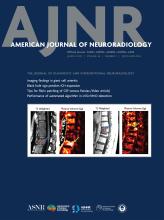This article requires a subscription to view the full text. If you have a subscription you may use the login form below to view the article. Access to this article can also be purchased.
Graphical Abstract
Abstract
BACKGROUND AND PURPOSE: ASPECTS is a long-standing and well-documented selection criterion for acute ischemic stroke treatment; however, the interpretation of ASPECTS is a challenging and time-consuming task for physicians with notable interobserver variabilities. We conducted a multireader, multicase study in which readers assessed ASPECTS without and with the support of a deep learning (DL)-based algorithm to analyze the impact of the software on clinicians’ performance and interpretation time.
MATERIALS AND METHODS: A total of 200 NCCT scans from 5 clinical sites (27 scanner models, 4 different vendors) were retrospectively collected. The reference standard was established through the consensus of 3 expert neuroradiologists who had access to baseline CTA and CTP data. Subsequently, 8 additional clinicians (4 typical ASPECTS readers and 4 senior neuroradiologists) analyzed the NCCT scans without and with the assistance of CINA-ASPECTS (Avicenna.AI), a DL-based, FDA-cleared, and CE-marked algorithm designed to compute ASPECTS automatically. Differences were evaluated in both performance and interpretation time between the assisted and unassisted assessments.
RESULTS: With software aid, readers demonstrated increased region-based accuracy from 72.4% to 76.5% (P < .05) and increased receiver operating characteristic area under the curve (ROC AUC) from 0.749 to 0.788 (P < .05). Notably, all readers exhibited an improved ROC AUC when utilizing the software. Moreover, the use of the algorithm improved the score-based interobserver reliability and correlation coefficient of ASPECTS evaluation by 0.222 and 0.087 (P < .0001), respectively. Additionally, the readers’ mean time spent analyzing a case was significantly reduced by 6% (P < .05) when aided by the algorithm.
CONCLUSIONS: With the assistance of the algorithm, readers’ analyses were not only more accurate but also faster. Additionally, the overall ASPECTS evaluation exhibited greater consistency, fewer variabilities, and higher precision compared with the reference standard. This novel tool has the potential to enhance patient selection for appropriate treatment by enabling physicians to deliver accurate and timely diagnoses of acute ischemic stroke.
ABBREVIATIONS:
- AI
- artificial intelligence
- DL
- deep learning
- EIC
- early ischemic changes
- ICC
- intraclass correlation coefficient
- IS
- ischemic stroke
- ROC AUC
- receiver operating characteristic area under the curve
- SD
- standard deviation
- © 2025 by American Journal of Neuroradiology













